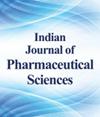In Vitro Antioxidant Assay of Different Phytoconstituents and Extraction Optimization of Phenolics from Cyperus rotundus L
IF 0.4
4区 医学
Q4 PHARMACOLOGY & PHARMACY
Indian Journal of Pharmaceutical Sciences
Pub Date : 2023-01-01
DOI:10.36468/pharmaceutical-sciences.1072
引用次数: 0
Abstract
Varshney et al. : Quantitative Estimation and Antioxidant Activity of Cyperus rotundus Oxidative stress related disorders occur as a result of free radicals in the cellular organs. Antioxidants provide protection contrary to oxidative stress by counteracting free radicals through the help of different bioactive constituents present in the plants. The aim of this study is to find out the quantitative estimation of phytochemicals (phenolics, tannins, flavonoid, non-tannins, alkaloid and saponins), in vitro antioxidant activity (2, 2-diphenyl-1-picryl-hydrazyl-hydrate, metal chelating, ferric reducing, superoxide dismutase and total antioxidant activity) of different parts of Cyperus rotundus . Along with this, the extraction of polyphenolic compounds by conventional and non-conventional methods and their optimization by response surface methodology technique were also studied. As the outcomes of the study, maximum amount of total phenolics content was found in the ethanolic fraction of stem (37.88±0.94 mg gallic acid equivalent/g). The root has shown the highest flavonoid (0.24±0.03 mg QAE/g) and non-tannin content (21.55±2.43 mg gallic acid equivalent/g) in the extract of petroleum ether. The total alkaloids and tannin content in flower and root i.e., 5.05±0.08 mg caffeine equivalent/g and 76.28±0.62 mg tannic acid equivalent/g was found to be better in aqueous extract respectively. The fraction of ethyl acetate has reported the greatest saponin content (39.2±3.8 mg gallic acid equivalent/g). In case of flower part half-maximal inhibitory concentration value of 2, 2-diphenyl-1-picryl-hydrazyl-hydrate and superoxide dismutase antioxidant activity varies from 0.57-1.90 mg/ml and from 0.053-1.401 mg/ml respectively. Antioxidant activity of each part of the plant was reported in the fraction of ethanol and water by fluorescence recovery after photobleaching (0.403±0.009-0.886±0.02 mg/ml), metal chelation activity (0.010±0.0-0.306±0.001 mg/ml) and total antioxidant capacity (0.030±0.0-0.317±0.002 mg/ml). Microwave assisted extraction method was found to be the suitable one for optimization of total phenolic content. So, the relationship between different parameter was determined through response surface methodology technique and evaluated by plotting the graphs. Polar extracts have found to show the maximum quantity of secondary bioactive metabolites and antioxidant activity as compared to non-polar one. And among the comparison between conventional and non-conventional methods, ultra sonication (non-conventional method) has shown the highest yield of bioactive phenolic compound. So, this study shows that Cyperus rotundus has wide range of secondary metabolites showing antioxidant properties that can be applied for different therapeutic applications.香附不同植物成分体外抗氧化活性测定及酚类物质提取工艺优化
氧化应激相关疾病的发生是细胞器官中自由基的结果。抗氧化剂通过植物中存在的不同生物活性成分的帮助来对抗自由基,从而提供对抗氧化应激的保护。摘要本研究的目的是对香附不同部位的植物化学物质(酚类物质、单宁类物质、黄酮类物质、非单宁类物质、生物碱和皂苷)、体外抗氧化活性(2,2 -二苯基-1-苦味基-水合肼、金属螯合、铁还原、超氧化物歧化酶和总抗氧化活性)进行定量评价。同时,对常规和非常规方法提取多酚类化合物及其响应面法优化进行了研究。结果表明,茎的乙醇部分总酚类物质含量最高(37.88±0.94 mg没食子酸当量/g)。石油醚提取物中黄酮类化合物含量最高(0.24±0.03 mg QAE/g),非单宁含量最高(21.55±2.43 mg没食子酸当量/g)。花和根的总生物碱和单宁含量分别为5.05±0.08 mg咖啡因当量/g和76.28±0.62 mg单宁酸当量/g。乙酸乙酯的皂苷含量最高(39.2±3.8 mg没食子酸当量/g)。2,2 -二苯基-1-苦味基-水合肼和超氧化物歧化酶抗氧化活性的半最大抑制浓度值分别为0.57 ~ 1.90 mg/ml和0.053 ~ 1.401 mg/ml。光漂白后荧光回收率测定了乙醇和水组分中各部位的抗氧化活性(0.403±0.009 ~ 0.886±0.02 mg/ml)、金属螯合活性(0.010±0.0 ~ 0.306±0.001 mg/ml)和总抗氧化能力(0.030±0.0 ~ 0.317±0.002 mg/ml)。微波辅助提取法是优化总酚含量的最佳方法。因此,通过响应面法技术确定了各参数之间的关系,并通过绘制图形来评价。与非极性提取物相比,极性提取物显示出最大数量的次生生物活性代谢物和抗氧化活性。在常规方法和非常规方法的比较中,超声波(非常规方法)的生物活性酚类化合物收率最高。因此,本研究表明,香草具有广泛的次生代谢物,具有抗氧化特性,可用于不同的治疗应用。
本文章由计算机程序翻译,如有差异,请以英文原文为准。
求助全文
约1分钟内获得全文
求助全文
来源期刊

Indian Journal of Pharmaceutical Sciences
PHARMACOLOGY & PHARMACY-
自引率
0.00%
发文量
0
审稿时长
2 months
期刊介绍:
The Indian Journal of Pharmaceutical Sciences (IJPS) is a bi-monthly Journal, which publishes original research work that contributes significantly to further the scientific knowledge in Pharmaceutical Sciences (Pharmaceutical Technology, Pharmaceutics, Biopharmaceutics, Pharmacokinetics, Pharmaceutical/Medicinal Chemistry, Computational Chemistry and Molecular Drug Design, Pharmacognosy and Phytochemistry, Pharmacology and Therapeutics, Pharmaceutical Analysis, Pharmacy Practice, Clinical and Hospital Pharmacy, Pharmacovigilance, Pharmacoepidemiology, Pharmacoeconomics, Drug Information, Patient Counselling, Adverse Drug Reactions Monitoring, Medication Errors, Medication Optimization, Medication Therapy Management, Cell Biology, Genomics and Proteomics, Pharmacogenomics, Bioinformatics and Biotechnology of Pharmaceutical Interest). The Journal publishes original research work either as a Full Research Paper or as a Short Communication. Review Articles on current topics in Pharmaceutical Sciences are also considered for publication by the Journal.
 求助内容:
求助内容: 应助结果提醒方式:
应助结果提醒方式:


